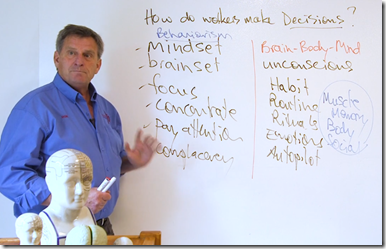Originally posted on October 25, 2020 @ 6:09 PM
How Workers Really Make Decisions
Latest video by Dr Rob Long as a follow up to his previous article: How Do Workers Make Decisions?
Video Transcript (video below this):
 I’m asked many, many times this question: “how do workers make decisions?” And, I decided I’ll answer that with a brief video. So let’s talk about what people currently think about how people make decisions. Most of what’s currently running through the market, particularly in risk and health and safety is that the brain is the controller of decisions. And I’m sorry to tell you, that’s not matched by the research. If you look at the current approach to risk and safety and how people make decisions, there’s a lot of focus now on what people call a mind set or a brain set. And this pulls the focus away from the whole body. The head-heart-gut pulls that away and it just puts it, all our decisions are up here. So we think about things such as all a worker has to be focused, that to concentrate.
I’m asked many, many times this question: “how do workers make decisions?” And, I decided I’ll answer that with a brief video. So let’s talk about what people currently think about how people make decisions. Most of what’s currently running through the market, particularly in risk and health and safety is that the brain is the controller of decisions. And I’m sorry to tell you, that’s not matched by the research. If you look at the current approach to risk and safety and how people make decisions, there’s a lot of focus now on what people call a mind set or a brain set. And this pulls the focus away from the whole body. The head-heart-gut pulls that away and it just puts it, all our decisions are up here. So we think about things such as all a worker has to be focused, that to concentrate.
Yeah, they have to pay attention, et cetera. And then what happens is when something goes wrong, these become the checklist for how we blame the worker. And you hear lots of language about, Oh, that worker was complacent, et cetera. Right? And so complacency’s another one of these where we tick the box, all of this stuff, that’s currently running at the moment in how workers make decisions come from a behaviours mindset. And this is about research. It’s about seventy years old. So behaviourism is the current theory that tells us that this is the way people make decisions. It’s not, there’s a whole bunch of new research. There’s a whole lot of new research that tells us that the brain, the body and the mind (which is not the brain) are all connected, all connected. And so everything from even your digestion, from your stress rate, your heart rate, all are critical factors in how decisions are made. And a lot of this is unconscious.
All of this stuff seems to give the idea that we know what we’re talking about. And somehow the behaviourist knows how the unconscious works. Most of this is just rhetoric. It’s not anchored to any research reality at all. So things that do matter, habit habit is the unconscious repetition of something without thinking routine, the same little rituals that people have in the way they do things. All of these things are unconscious. They’re not consciously thought about. We often talk about even how our emotions work. And then sometimes we even have things like we talk about autopilot, that human beings simply able to do things in a trance. There’s much, much deeper parts to this in the research. We now know that human beings have such things called muscle memory.
Now, muscle memory says that the memories in your muscles, it’s not directed in your brain. We have body memory, we have social memory. And so, yeah, there are a range of different memories we have, which are not part of this behaviours, paradigm, this behaviours way of thinking. So we need to think much, much more about these sorts of things. If we want to address work health and safety in a holistic way at the moment, all this language leads to is blame the worker project on the worker. Somehow the worker was an idiot. Somehow the worker needs to be blind. If we focused more on these things, the unconscious things what’s called the brain body mind problem, we might do a much better job of the way we manage risk on building sites. And so this needs to be imbalance.
Okay. And that’s how workers make decisions……………


Do you have any thoughts? Please share them below